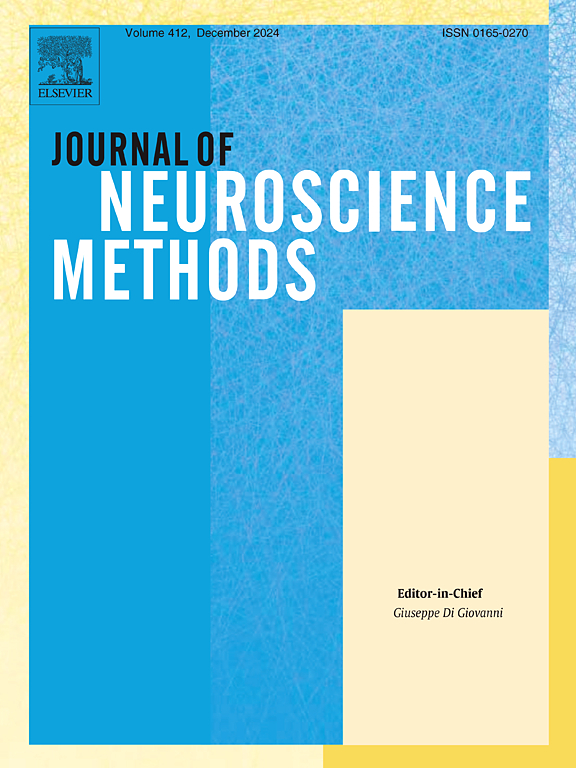High-fidelity detection and quantification of acoustic startle response in freely moving mice in an open field
IF 2.3
4区 医学
Q2 BIOCHEMICAL RESEARCH METHODS
引用次数: 0
Abstract
Background:
Acoustic startle response (ASR) is an involuntary reflex to an intense acoustic stimulus, characterized by rapid muscle contractions. Traditional ASR testing requires animals to be placed in spatially confining chambers to minimize voluntary movements, potentially altering natural behavior and stress levels. A method for detecting and quantifying ASR in free-moving rodents is needed.
New method:
This study presents a novel methodology and fully functional setup for measuring ASR in freely moving mice. The approach utilizes acoustic emissions (AE) generated by the animal’s startling. The setup features an open field equipped with sensitive AE sensors to capture ASR with high precision and resolution.
Results:
In an open field fitted with AE sensors, ASR experiments were conducted on three mouse strains (129S6/EvSv, CBA/CaJ, and C57BL/6J). The system’s ability to detect the effects of startle sound level, tone frequency, lighting conditions, stress levels, and genetic differences was evaluated. AE-based measures detected significant strain effects, with C57BL/6J mice showing lower startle intensities and higher latencies. Tone frequency and sound level influenced startle responses, while light/dark conditions had no effect. Stress conditioning resulted in elevated responses, but the difference was not statistically significant.
Comparison with existing methods:
Alongside AE data, video recordings from three orthogonal viewpoints were acquired and analyzed to quantify startling. Unlike AE-based measures, video analysis failed to detect strain effects but found significant effects of frequency, sound level, and stress conditioning (which the AE data did not detect).
Conclusions:
These findings validate AE-based technology for measuring ASR in freely moving rodents.
野外自由运动小鼠声惊反应的高保真检测与定量。
背景:声惊反应(ASR)是对强烈声刺激的不自主反射,以肌肉快速收缩为特征。传统的ASR测试要求将动物放在空间受限的房间中,以尽量减少自主运动,这可能会改变自然行为和压力水平。需要一种检测和量化自由活动鼠ASR的方法。新方法:本研究提出了一种新的方法和功能齐全的装置来测量自由运动小鼠的ASR。这种方法利用动物触电时产生的声发射(AE)。该装置的特点是一个开放的场地,配备了敏感的AE传感器,以高精度和高分辨率捕获ASR。结果:在安装声发射传感器的开阔场地,对3株小鼠(129S6/EvSv、CBA/CaJ和C57BL/6J)进行了ASR实验。该系统检测惊吓声级、音调频率、照明条件、压力水平和遗传差异的能力进行了评估。基于ae的测量检测到显著的应变效应,C57BL/6J小鼠表现出较低的惊吓强度和较高的潜伏期。音调频率和声音水平影响惊吓反应,而光/暗条件没有影响。应激调节导致应激反应升高,但差异无统计学意义。与现有方法的比较:与声发射数据一起,获取三个正交视点的视频记录并进行分析,以量化惊吓。与基于AE的测量不同,视频分析未能检测到应变效应,但发现了频率、声级和应力调节的显著影响(AE数据未检测到)。结论:这些发现验证了基于ae的测量自由活动啮齿动物ASR的技术。
本文章由计算机程序翻译,如有差异,请以英文原文为准。
求助全文
约1分钟内获得全文
求助全文
来源期刊

Journal of Neuroscience Methods
医学-神经科学
CiteScore
7.10
自引率
3.30%
发文量
226
审稿时长
52 days
期刊介绍:
The Journal of Neuroscience Methods publishes papers that describe new methods that are specifically for neuroscience research conducted in invertebrates, vertebrates or in man. Major methodological improvements or important refinements of established neuroscience methods are also considered for publication. The Journal''s Scope includes all aspects of contemporary neuroscience research, including anatomical, behavioural, biochemical, cellular, computational, molecular, invasive and non-invasive imaging, optogenetic, and physiological research investigations.
 求助内容:
求助内容: 应助结果提醒方式:
应助结果提醒方式:


